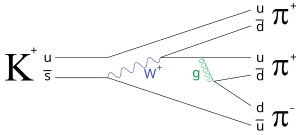
Back قائمة الميزونات Arabic Liste der Mesonen German Anexo:Tabla de mesones Spanish فهرست مزونها Persian Lista dei mesoni Italian 中間子の一覧 Japanese Список мезонов Russian Seznam mezonov Slovenian Mezonlar listesi Turkish 介子列表 Chinese

K+
) into three pions (2
π+
, 1
π−
) is a process that involves both weak and strong interactions.
Weak interactions: The strange antiquark (
s
) of the kaon transmutes into an up antiquark (
u
) by the emission of a
W+
boson; the
W+
boson subsequently decays into a down antiquark (
d
) and an up quark (
u
).
Strong interactions: An up quark (
u
) emits a gluon (
g
) which decays into a down quark (
d
) and a down antiquark (
d
).
- This list is of all known and predicted scalar, pseudoscalar and vector mesons. See list of particles for a more detailed list of particles found in particle physics.
This article contains a list of mesons, unstable subatomic particles composed of one quark and one antiquark. They are part of the hadron particle family—particles made of quarks. The other members of the hadron family are the baryons—subatomic particles composed of three quarks. The main difference between mesons and baryons is that mesons have integer spin (thus are bosons) while baryons are fermions (half-integer spin). Because mesons are bosons, the Pauli exclusion principle does not apply to them. Because of this, they can act as force mediating particles on short distances, and thus play a part in processes such as the nuclear interaction.
Since mesons are composed of quarks, they participate in both the weak and strong interactions. Mesons with net electric charge also participate in the electromagnetic interaction. They are classified according to their quark content, total angular momentum, parity, and various other properties such as C-parity and G-parity. While no meson is stable, those of lower mass are nonetheless more stable than the most massive mesons, and are easier to observe and study in particle accelerators or in cosmic ray experiments. They are also typically less massive than baryons, meaning that they are more easily produced in experiments, and will exhibit higher-energy phenomena sooner than baryons would. For example, the charm quark was first seen in the J/Psi meson (
J/ψ
) in 1974,[1][2] and the bottom quark in the upsilon meson (
ϒ
) in 1977.[3] The top quark (the last and heaviest quark to be discovered to date) was first observed at Fermilab in 1995.
Each meson has a corresponding antiparticle (antimeson) where quarks are replaced by their corresponding antiquarks and vice versa. For example, a positive pion (
π+
) is made of one up quark and one down antiquark; and its corresponding antiparticle, the negative pion (
π−
), is made of one up antiquark and one down quark. Although tetraquarks with two quarks and two antiquarks can be considered mesons they are not listed here.
The symbols encountered in these lists are: I (isospin), J (total angular momentum), P (parity), C (C-parity), G (G-parity), u (up quark), d (down quark), s (strange quark), c (charm quark), b (bottom quark), Q (charge), B (baryon number), S (strangeness), C (charm), and B′ (bottomness), as well as a wide array of subatomic particles (hover mouse for name).
© MMXXIII Rich X Search. We shall prevail. All rights reserved. Rich X Search